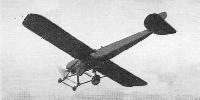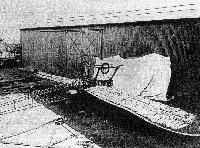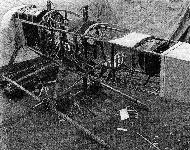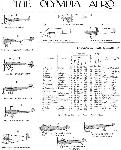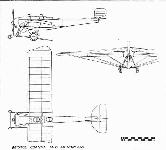
Описание
Страна: Великобритания
Год: 1912
C.Barnes Bristol Aircraft since 1910 (Putnam)
The Bristol-Coanda Monoplanes
Henri Coanda, son of Gen. Coanda the Rumanian War Minister, had trained as an engineer in France and was an artist of merit as well. He. Had studied under Eiffel, whose wind-tunnel at Auteuil was the first to be built in Europe. At the Paris Salon of 1910, Coanda exhibited a novel biplane whose engine drove, not an airscrew, but a small-diameter ducted fan. It is uncertain whether this biplane ever flew, as has been claimed, but Coanda deserves due credit for originating this form of propulsion unit. Another of Coanda's projects was a tandem-wing monoplane with a submerged engine driving an airscrew mounted half-way along a streamlined circular-section fuselage.
Coanda joined the Company's staff in January 1912, and his first product at Filton was an orthodox tandem two-seater monoplane (No. 77), derived from the Prier-Dickson. The wings were structurally Similar to Prier's, having two tubular steel spars filled with wood, on to which the ribs were threaded and located by clips so that they were free to rotate round the spars for warping. In Prier's design the front spars were always longer, than the rear, giving a forward rake to the tip, but this somewhat restricted the range of warping movement available. Coanda's wings had their tips raked the opposite way, with the rear spar longer than the front, which resulted in a longer flexible trailing edge. The wings were braced above and below to steel tube pylons, the control pulleys being enclosed in streamline fairings at the apex of each pylon. The 50 h.p. Gnome engine was surrounded by a circular cowling, which prevented oil from being thrown back to the cockpits. The undercarriage had steel-tube skids of the type originated by Grandseigne, and the cockpits were furnished with wicker seats and had non-inflammable celluloid windows in the fuselage sides. No. 77 was sent to Larkhill on 27 March 1912 and remained there for testing for some weeks. A second monoplane, No. 80, was similar but had side-by-side seats with dual controls. It was built in May 1912 and remained in continuous use as a school machine at Brooklands and Larkhill until crashed by Merriam and Gipps on 26 January 1914. Both these models were offered as suitable for training purposes and eventually five more of the tandem version and six more of the side-by-side version were built, all with 50 h.p. Gnomes, during 1913. Of the tandem version, No. 132 went to Italy and Nos. 185, 186, 188 and 189 to Rumania; and of the side-by-side version, Nos. 110 and 165 went to Italy and Nos. 164, 166 and 176 to Rumania, while the last, No. 177, was retained at Larkhill and was finally converted into the one and only side-by-side Coanda biplane No. 218.
On 15 May 1912 the War Office announced conditions for the Military Aeroplane Competition, and it was found that the competing aircraft had to be designed and built by 15 July! It was, of course, impossible to produce a new design specially to meet the conditions in only two months, and in any case the prize money, limited to ?5,000 to anyone entrant, hardly justified an all-out effort of this kind. However, Coanda had already made good progress with a new design for a military monoplane and two of these were entered, together with the two G.E.2 biplanes, in the competition. The rules laid great emphasis on suitability for reconnaissance and ease of maintenance and transport. Dual controls were required, together with a good view downwards and good stability, and the pilot was expected to start his engine and operate from unprepared fields without assistance. The aircraft had to be tendered at Larkhill packed in a rail transport crate not longer than 32 ft. and had to be capable of being towed on its own wheels or trolley in an army column. The flying tests were stringent and included duration, speed, altitude and climb minima, together with landing on various surfaces and quick take-off from a harrowed field. At least one flight had to be made in a wind averaging 25m.p.h. Coanda's two competition monoplanes, Nos. 105 and 106, were both equipped with the new 80 h.p. Gnome engine. Great attention had been paid to drag reduction and the usual pyramids of cabane struts were replaced by a pair of vertical steel pylons on the fuselage centre-line carefully faired with wood. The passenger's cockpit was between these pylons and the pilot's just behind, so that from a distance the machine appeared to have a crew of four. The wings were of the same type as on No. 77 and their cables had quick release clips for easy dismantling. The cockpit sides had celluloid windows and the trailing edges were cut back at the wing roots to improve the pilot's view. Like all Coanda monoplanes they had a semicircular fixed tailplane and a one-piece elevator, with a balanced rudder above. Busteed experienced directional instability on No. 105 with the original rudder, and a smaller Prier-type rudder was tried in conjunction with a fixed fin, but this was no better and the trouble was finally cured by a balanced rudder of revised outline. Nos. 105 and 106 (competition numbers 14 and 15) were flown by Busteed and Valentine, respectively. Valentine, attempting the duration test of3 hours in 15 had engine failure while approaching a flock of sheep and struck a fence in attempting to avoid them. The damage was soon repaired, but Valentine withdrew from the trials and Pixton was allowed to take his place.
Both Busteed and Pixton did well in the ensuring tests and eventually shared third place with the British Deperdussin in the final assessment and were awarded ?500 each. Pixton excelled in the rough weather test, with Capt. Patrick Hamilton, R.F.C., as passenger, when he took-off and remained up for over 15 min. in violent gusts whose recorded speed varied from 17 to 44 m.p.h. Pixton also headed the list in the range test with 420 miles, while Busteed was third in the high speed test with 73 m.p.h., only 2 m.p.h. less than the best. Neither succeeded in taking-off from a harrowed field and Coanda quickly appreciated that the wing-loading was somewhat too high; all subsequent monoplanes of the type had larger wings and the details were carefully redesigned to save weight. These improvements cou1d have been made before the competition began, had more time been available. Both Nos. 105 and 106 were bought by the War Office and received military serials 263 and 262 respectively. Training was begun on them in preparation for the autumn manoeuvres, and on 10 September Edward Hotchkiss, by then a second-Lt. in the Special Reserve, with Lt. C. A. Bettington, R.F.C., as passenger left Larkhill to fly to Hardwick, near Cambndge, on 263. They intended to land at the Port Meadow, Oxford, and while gliding down from 2,000 ft. above Wolvercote Hotchkiss lost control; the descent became a steep dive and the starboard wing fabric tore off, both men being killed instantly. It appeared that the quick-release clip of one of the flying wires had become detached, but, as this was not the first of several similar accidents, the War Office somewhat summarily banned the flying of all monoplanes by pilots of the Military Wing, R.F.C.; no such ban was imposed on Naval pilots by the Admiralty and indeed the War Office ban was lifted five months later, but it ended the Company's hopes of supplying Coanda monoplanes in quantity to the Royal Flying Corps. Foreign interest in the design remained, however, and enquiries were received from Italy and Rumania for the improved model with span increased from 40 ft. to 42 ft. 9 m., which became standardised for production.
A single experimental variant, which was not a success, emerged in September 1912 alongside the first of the production batch. This was No. 111, nicknamed The Elephant. It was intended to compete with the strongly built Etrich and D.F.W. monoplanes favoured by the German Army and had a welded steel-tube landing gear with a central skid; the shock absorbers were telescopic struts containing coil springs and the half-axles could be moved by a tiller-bar for ground steering. The engine was the 70 h.p. Daimler-Mercedes from the unlucky G.E.2 biplane, and the machine was sent to Larkhill for testing with two sets of wings, one set being of normal profile, while the other had a very pronounced camber based on the aerofoil section known as the 'Phillips Entry'. It was seriously overweight and failed to fly successfully with either set of wings, so was never sent to Deutsche Bristol-Werke as had been intended.
The first production Coanda military monoplane, No. 118, had extra fuel and oil tanks and an enlarged rudder and was taken to Bucharest in September by Prince Cantacuzene, head of the Rumanian military aviation mission which had come to Larkhill to study' Bristol' methods and products. Pixton demonstrated this monoplane in the Rumanian army manoeuvres with great success. Two others, Nos. 121 and 122, were built for the Italian government, and No. 122 was dispatched to Turin on 13 November, but No. 121 remained at Larkhill and was destined to have a remarkable career. The fourth production monoplane in the batch was No. 123, which was Prince Cantacuzene's personal mount, but he crashed it while taxying, and after being rebuilt as No. 142, it became a static test airframe. The next of the series, No. 131, was specially finished for the Paris Salon of 1912, with a streamlined chassis with filleted strut junctions. It so impressed the Italian authorities that they purchased it in preference to No. 121 and ordered 12 more for urgent delivery. Rumania also ordered ten, and both countries had sent officers to Larkhill for instruction in December. No. 131 was dispatched to Turin on 6 December 1912, together with school monoplane No. 132, as initial equipment for the Italian military aviation school.
Enthusiasm for the Coanda monoplane increased as experience was gained, and the Company appeared to have overcome the set-back caused by the War Office ban. A new production batch of 12 monoplanes was laid down, numbered 143 to 154 inclusive, the first two being retained at Larkhill for test and demonstration, and No. 145, which had a modified chassis, being sent to Spain on 23 December after a marathon effort to dispatch it before the Christmas holiday. No. 146, the first of four for Rumania, was not ready until February 1913, having been held up while Coanda rechecked the stress calculations and performed static tests with sand-bags on the inverted airframe of No. 142, at the request of Prince Cantacuzene. Satisfied with the results, all was ready for acceptance flight testing to begin as soon as the weather permitted, and on 5 March 1913 Gordon England's younger brother Geoffrey undertook a 1 hour duration test on No. 146 although the wind was still too strong for the altitude test. After flying for 39 min., the machine was struck by a violent gust which caused the port wing to collapse and Geoffrey England was killed. Prior to this accident the Coanda monoplane had been selected for purchase by the Italian National Subscription, which had raised nearly ?800,000 to buy aeroplanes for the army and had ordered 36 more of the type to be built in Italy by Italian labour. The Company had been asked to grant a manufacturing licence to an established firm in Italy, and Caproni & Faccanoni, of Vizzola Ticino, had been recommended as the most reliable of the three or four constructors of that time. A condition for granting the licence was that the first few Italian-built machines should be test-flown by Bristol pilots, and the formal agreement setting up the Societa Italiana Bristol Aeroplani was signed on 31 December 1912 by Henry White Smith, who, with Capt. Dickson, had supervised the Caproni factory arrangements. These included the supply from Filton of a complete skeleton monoplane (No. 154) as a pattern and the loan of a picked party of Filton erectors to teach their Italian colleagues 'Bristol' methods in addition to the normal provision of drawings and data.
Delivery tests of Nos. 122, 131 and 132 were undertaken by Sidney Sippe, who had just joined the Bristol staff, and in December Pixton went to Turin on his return from Rumania and put No. 131 through its paces, breaking records for climb and speed with full load. He then went to Madrid and during the trials of No. 145 at Cuatros Vientos repeated his Turin performance. He also took up as passengers the Infante of Spain and his uncle, Prince Leopold of Battenburg. Meanwhile Sippe remained in Italy to await assembly of the first two Caproni-built monoplanes. These were generally satisfactory in workmanship, but the warp control was found to be immovable and on examination it was found that the ribs had been bolted to the spars, thus destroying the flexibility of the wing which was an essential feature of the design. In January a new flying school, based on Larkhill practice, was opened at Malpensa and Collyns Pizey went out to begin instruction. He stayed until April when new Italian military aircraft trials were to be held between Turin and Milan, for which two Caproni-Bristols had been entered. The events were ruined by incessant rain, turning the flying ground into a sea ofmud and the Caproni-Bristols proved unequal to the task. As a result the Italian Government cancelled the Bristol contract and after a prolonged dispute which lasted until January 1918 the Caproni-Bristol licence was cancelled.
After the loss of No. 146, delivery of the remainder of the Rumanian monoplanes was held in abeyance, but a specially finished Coanda monoplane, No. 153, was exhibited at Olympia in February, featuring wheel brakes and armoured glass fuselage windows. Together with Nos. 150 and 151 it was sent to the Deutsche Bristol-Werke in April 1913, but Nos. 151 and 153 were returned to Filton in August. No. 152 was held as a replacement for No. 146 on the Rumanian contract, and the final example, No. 196, was one of the Caproni-Bristols shipped to Filton in August 1913 for conversion into a biplane. The Rumanian monoplanes were fitted with strengthened wings, but this detracted seriously from their performance and eventually a happy compromise was found in the conversion of the whole batch into biplanes, which proved very successful indeed.
SPECIFICATIONS AND DATA
Type: Coanda Monoplanes
Manufacturers:
The British & Colonial Aeroplane Co., Ltd., Filton, Bristol
Deutsche Bristol-Werke, Halberstadt, Germany
Caproni & Faccanoni, Vizzola Tieino, Varese, Italy
Model School Side by side Competition Daimler Military
Power plant 50 hp Gnome 50 hp Gnome 80 hp Gnome 70 hp Daimler 80 hp Gnome
Span 40 ft 41 ft 3 in 40 ft 39 ft 4 in 42 ft 9 in
Length 27 ft 27 ft 28 ft 3 in 30 ft 9 in 29 ft 2 in
Height 7 ft 7 ft 7 ft 7 ft 7 ft
Wing Area 275 sq ft 275 sq ft 242 sq ft 260 sq ft 280 sq ft
Empty Weight 770 lb 770 lb 1,000 lb 1,200 lb 1,050 lb
All-up Weight 1,100 lb 1,100 lb 1,710 lb 1,850 lb 1,775 lb
Speed 65 mph 65 mph 73 mph 60 mph 71 mph
Accommodation 2 2 2 2 2
Production 6 7 2 1 21
Sequence Nos. 77 132 80 110 164- 105 106 111 118 121-
185 186 166 176 177 123 131
188 189 142-154
(196+one in
Italy)
Описание:
- C.Barnes Bristol Aircraft since 1910 (Putnam)
- M.Goodall, A.Tagg British Aircraft before the Great War (Schiffer)
- P.Lewis British Aircraft 1809-1914 (Putnam)
- Jane's All The World Aircraft 1913
- J.Davilla Italian Aviation in the First World War. Vol.2: Aircraft A-H (A Centennial Perspective on Great War Airplanes 74)
- Журнал Flight
Фотографии
-
J.Davilla - Italian Aviation in the First World War. Vol.2: Aircraft A-H /Centennial Perspective/ (74)
Bristol Coanda Monoplane on display with an SVA in the background.
Другие самолёты на фотографии: Ansaldo SVA.2/3/4/5 - Италия - 1917
-
C.Barnes - Bristol Aircraft since 1910 /Putnam/
Coanda School monoplane No.132 at Filton in November 1912.
-
P.Lewis - British Aircraft 1809-1914 /Putnam/
Bristol Coanda Improved Military Monoplane.
-
P.Lewis - British Aircraft 1809-1914 /Putnam/
Bristol Coanda Military Trials Monoplane without fin.
-
M.Goodall, A.Tagg - British Aircraft before the Great War /Schiffer/
Bristol Coanda monoplane Works No.105 of 1912. No.14 in the Military Trials.
-
Журнал - Flight за 1912 г.
Bristol Coanda Military Trials Monoplane with fin which secured a third prize of L500 in the Military Trials.
-
Журнал - Flight за 1912 г.
THE MILITARY COMPETITION MACHINES. - The Bristol monoplane. Two machines of this type have been entered. One will be flown by Mr. James Valentine, and the other fay Mr. H. Busteed.
-
C.Barnes - Bristol Aircraft since 1910 /Putnam/
Busteed in Coanda No. 106, competing at Larkhill in August 1912.
-
Журнал - Flight за 1912 г.
THE MILITARY AVIATION TESTS. - Busteed preparing to start off for a trial spin on one of the Bristol military monoplanes.
-
Журнал - Flight за 1912 г.
BRISTOLS IN ROUMANIA. - A snapshot at the Bucharest Military Aerodrome. Standing in front of the 80-h.p. Bristol monoplane, from right to left: Lieut. Protopopescu (who on Thursday week, after only three days' tuition, made a flight of an hour, getting up to 2,000 ft.), another Lieutenant (who acted as observer in the official trials), Mr. C. H. Pixton, Major Macree (in command of the Flying Corps), beside whom is a Lieutenant (who is now being taught by Lieut. Protopopescu), and the two mechanics who accompanied Mr. Pixton to Roumania.
-
Журнал - Flight за 1913 г.
THE ITALIAN GOVERNMENT ORDER FOR BRITISH AEROPLANES. - One of the 80-h.p. Bristol monoplanes on the Mirafiori ground at Turin. On the extreme left is Mr. White Smith, Secretary of the British and Colonial Aeroplane Co., Ltd.; next to him, with muffler on, is the Chief of the Aviation Department in Milan; Pixton is just getting into the pilot's seat, and one of the Bristol mechanics is standing by the propeller.
-
R.Abate, G.Alegi, G.Apostolo - Aeroplani Caproni: Gianni Caproni and His Aircraft, 1910-1983
In April 1913 Turin hosted the military aircraft and engine competition advertised by the War Ministry in late 1912. In addition to a 10,000 lire cash prize, it was announced that the winning and second placed designs would be ordered in ten and five copies respectively. The Caproni e Faccanoni company entered two Bristol Caproni 80 hp monoplanes, flown by the English pilots Sidney Sippe and Collyns Pizey and identified respectively with contest numbers 11 and 13. The Bristol was a design of Henri Coanda, Caproni’s classmate in Belgium. Since the Army already employed other Bristols, Caproni secured a production license as a fallback in case his Caproni 1913 could not be readied in time. Neither of the Bristols was admitted to the final trials, but a static test was held at Mirafiori on April 17 using a fuselage imported from England in December. Despite the results of the competition, Caproni eventually supplied several Bristols to the Army, the military flying field at Somma Lombardo, near Malpensa, becoming the seat of the Bristol Caproni monoplane school with tenente Renato De Riso as instructor. Maintenance and repairs were entrusted to Caproni, who modified some aircraft with a movable tailplane. Another modification, carried out by the Hendon graduate capitano Ercole Ercole, involved applying brakes to the wheels. Some Bristols were returned to the British company in late March 1913, but others continued in the training role throughout 1914. A British built Bristol, with fuselage number 174, is preserved by the Caproni Museum as the oldest extant Bristol in the world.
-
Журнал - Flight за 1912 г.
Messrs. Busteed (in the pilot's seat) and Harrison, snapped just before starting away in a 31-15 m.p.h. wind for a flight on the new military Bristol monoplane. The picture on the left shows the machine in flight.
-
Журнал - Flight за 1913 г.
Mr. C. H. Pixton just ready to start from the Four Winds Aerodrome, Madrid, for a flight on his Bristol monoplane, with the Infanta of Spain, who occupies the front seat, and is wearing a fine wire mask for protection against the wind.
-
J.Herris - Halberstadt Aircraft of WWI. Volume 1: A-types to C.III /Centennial Perspective/ (44)
Modified Halberstadt Bristol Coanda with enclosed cowling and 4-wheel undercarriage gives this primitive aircraft a more modern appearance. (Peter M. Grosz collection/STDB)
-
J.Herris - Halberstadt Aircraft of WWI. Volume 1: A-types to C.III /Centennial Perspective/ (44)
Halberstadt Bristol Coanda in flight.
-
Журнал - Flight за 1913 г.
AT THE SETTING OF THE SUN. - A fine glide, the actual angle being 1 in 7.9, into the Cuatro Vientos Aerodrome, Madrid, by Mr. C. H. Pixton on a Bristol monoplane. This was the conclusion of a fifteen minutes' flight with the Infanta of Spain.
-
Журнал - Flight за 1913 г.
Mr. F. Warren Merriam making a fine high flight on the Bristol tandem monoplane at Salisbury Plain on October 10th.
-
C.Barnes - Bristol Aircraft since 1910 /Putnam/
Coanda Military monoplane No. 150 flying at Halberstadt in 1913.
-
Журнал - Flight за 1912 г.
THE BRISTOL MILITARY MACHINES IN FLIGHT. - In the centre the monoplane, and on either side the tractor biplane.
Другие самолёты на фотографии: Bristol GE.2 - Великобритания - 1912
-
Журнал - Flight за 1912 г.
THE BRISTOL MONOPLANE. - One of the two British representatives at the Salon.
-
Журнал - Flight за 1912 г.
Representative stand at the Salon - the Bristol.
-
P.Jarrett - Pioneer Aircraft: Early Aviation Before 1914 /Putnam/
One of the monoplanes that came under suspicion was the Bristol Coanda. THis one is undergoing a manufacturer's wing-loading test in 1912, inverted with loose sand and sandbags spread over the underside of its wings.
-
Журнал - Flight за 1912 г.
M. Coanda, the designer of the Bristol monoplane, which did so well in the various tests in the British Military Aeroplane Trials.
-
P.Jarrett - Pioneer Aircraft: Early Aviation Before 1914 /Putnam/
A Bristol Coanda monoplane under construction. Designed by Rumanian Henri Coanda, these monoplanes found favour and orders on the European continent.
-
Журнал - Flight за 1912 г.
Mr. Busteed, the pilot of the Bristol monoplane No. 14, which obtained one of the L600 third prizes for British aeroplanes in the Military Trials.
-
C.Barnes - Bristol Aircraft since 1910 /Putnam/
Capt. Bertram Dickson as passenger, with Mr. C. H. Pixton as pilot, about to set out for a flight on one of the 80-h.p. Bristol monoplanes at Turin during the tests by the Italian Government before taking over the Bristol monoplanes on order. This is the first aeroplane trip made by Capt. Dickson in Italy since his well-remembered accident at Milan when he had the terrible collision in the air with Thomas, another aviator.
-
Журнал - Flight за 1913 г.
Mr. Henry M. Jullerot, the Manager and Chief Pilot of the Bristol School at Salisbury Plain, on one of the 80-h.p. school monoplanes, with Capt. Landon, a very promising pupil, as passenger.
-
Журнал - Flight за 1913 г.
The 80-h.p. Bristol monoplane.
-
Журнал - Flight за 1913 г.
The 80-h.p. Bristol monoplane.
-
Журнал - Flight за 1913 г.
BRISTOL MACHINE DETAILS. - The tail on the left is a standartised unit, it being identical on both the monoplane and the biplane. The sketch on the right shows the flexible suspensioon of one of the main landing-wheels, with its band-brake and torque-rod.
-
Журнал - Flight за 1912 г.
Details of one of the front wheels of the Bristol.
-
Журнал - Flight за 1913 г.
The original method of cane suspension of the seats of the Bristol machine.
-
Журнал - Flight за 1913 г.
The laminated rear end of the Bristol monoplane skid.
-
Журнал - Flight за 1913 г.
Другие самолёты на фотографии: Bleriot Bleriot-XI-2 - Франция - 1911Breguet 3 - Франция - 1910Bristol BR.7 - Великобритания - 1913Caudron C / D / E - Франция - 1912Caudron N - Франция - 1911Cody No.5 - Великобритания - 1912Deperdussin hydro-monoplane - Франция - 1912Deperdussin Racer - Франция - 1912Farman HF.15/16/20 - Франция - 1912Maurice Farman MF.7 Longhorn - Франция - 1912RAF B.E.2/B.E.2a/B.E.2b - Великобритания - 1912
-
Журнал - Flight за 1913 г.
A study in tails.
Другие самолёты на фотографии: Bleriot Bleriot-XI-2 - Франция - 1911Breguet 3 - Франция - 1910Deperdussin Racer - Франция - 1912Handley Page Type E / H.P.5 - Великобритания - 1912Nieuport Nieuport-IV Hydro / Nieuport-VI - Франция - 1912RAF B.E.2/B.E.2a/B.E.2b - Великобритания - 1912Sopwith Bat Boat - Великобритания - 1913Sopwith Three-Seater - Великобритания - 1913Vickers EFB.1 - Великобритания - 1913
-
Журнал - Flight за 1915 г.
Various types of double skid undercarriages.
Другие самолёты на фотографии: Caudron G.3 - Франция - 1913Dyott monoplane - Великобритания - 1913Farman HF.15/16/20 - Франция - 1912Maurice Farman MF.11 Shorthorn - Франция - 1913Sopwith Tabloid - Великобритания - 1913
-
C.Barnes - Bristol Aircraft since 1910 /Putnam/
Bristol Coanda W.O. monoplane
-
P.Lewis - British Aircraft 1809-1914 /Putnam/
Bristol Daimler
-
J.Herris - Halberstadt Aircraft of WWI. Volume 1: A-types to C.III /Centennial Perspective/ (44)
Halberstadt Bristol Coanda
-
Журнал - Flight за 1913 г.
THE BRISTOL MONOPLANE. - Plan, side and front elevation to scale.
-
Jane's All The World Aircraft 1913 /Jane's/
80 h.p. monoplane.




















